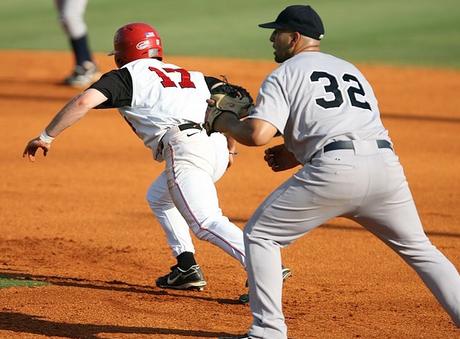
Sometimes you steal on the pitcher. Other times it’s on the first baseman.
In Part 1 of this series I discussed what stealing first-move means and why it can be a very good option when a left-hander is on the mound. In Part 2 I wanted to cover some of the little things the offense needs to do in order to increase the chances of the play turning out in their favor. As you will see, many of the things I explain involve things to pay attention to well before a runner even gets to first base. Good intel is key!
Here are some tips (in no particular order) for the offensive team:
- Pay attention to the first baseman’s movements around the bag during pre-game and pre-inning warm-ups. Look for weak arms, slow transitions, bad hands, poor footwork, and inaccurate throws that will lead to a tougher time getting the ball to second base.
- Pay attention to the pitcher during pre-game and pre-inning warm-ups as well. What does his delivery to home plate look like from the stretch? Slow? Quick? If it is very slow than his pick-off move to first is probably slow as well.
- Pay attention to all his prior pick-off moves. Do all of them involve a slow move to first or does he mix up his speeds. Obviously, if all his moves to first are slow then the next one will probably be the same making him a candidate to steal first-move on.
- Pay attention to the middle infielders. Are they close to second base with a runner on first or are they positioned too far away? Does their attention drift? Are they lazy or do they have their heads on a swivel and therefore constantly alert? Sometimes a team can steal first-move more so because of bad middle infielders than bad first basemen.
- Take a bigger lead. On a first-move steal there is no reason to take a short lead. You shouldn’t care if you get picked off. If a decision to go first-move is made then you already have done your homework and know your chances of being safe are high. Increase your lead at first and cut the distance of your sprint to second base. Who cares if he throws over to first? That’s what you want!
- Drift into the throwing lane. If the runner takes off on first move and notices that the pitcher has thrown to first base, the runner should “drift” a little into the throwing lane to disrupt the first baseman’s throw. Click HERE for a post I did on that technique.
A left-hander with a great pick-off move can be tough to steal on but he doesn’t have to completely eliminate the running game if you and your players know what to look for and what to do with that information.
The last part in this series on stealing first-move is for the defense. Stay tuned!

